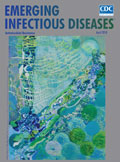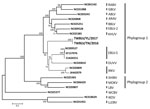
Volume 24, Number 4—April 2018
Dispatch
Lyssavirus in Japanese Pipistrelle, Taiwan
On This Page
Shu-Chia Hu, Chao-Lung Hsu, Ming-Shiuh Lee, Yang-Chang Tu, Jen-Chieh Chang, Chieh-Hao Wu, Shu-Hwae Lee, Lu-Jen Ting, Kwok-Rong Tsai, Ming-Chu Cheng, Wen-Jane Tu, and Wei-Cheng Hsu
Abstract
A putative new lyssavirus was found in 2 Japanese pipistrelles (Pipistrellus abramus) in Taiwan in 2016 and 2017. The concatenated coding regions of the virus showed 62.9%–75.1% nucleotide identities to the other 16 species of lyssavirus, suggesting that it may be representative of a new species of this virus.
The Lyssavirus genus within the family Rhabdoviridae is composed of 14 species of lyssavirus: rabies lyssavirus (RABV), Lagos bat lyssavirus (LBV), Mokola lyssavirus (MOKV), Duvenhage lyssavirus (DUVV), European bat 1 lyssavirus (EBLV-1), European bat 2 lyssavirus (EBLV-2), Australian bat lyssavirus (ABLV), Aravan lyssavirus (ARAV), Khujand lyssavirus (KHUV), Irkut lyssavirus (IRKV), Shimoni bat lyssavirus (SHIBV), Bokeloh bat lyssavirus (BBLV), West Caucasian bat lyssavirus (WCBV), and Ikoma lyssavirus (IKOV) (1). In addition, Lleida bat lyssavirus (LLEBV) (1,2) and Gannoruwa bat lyssavirus (GBLV) (3) were recently identified in bats, but their taxonomic statuses have not been determined by the International Committee on the Taxonomy of Viruses. The genus Lyssavirus can be subdivided into phylogroup 1 (RABV, DUVV, EBLV-1, EBLV-2, ABLV, ARAV, KHUV, IRKV, BBLV, and GBLV) and phylogroup 2 (LBV, MOKV, and SHIBV) according to genetic distances and serologic cross-reactivity (1–3). The remaining species, WCBV, IKOV, and LLEBV, cannot be included in either of these phylogroups (1,2).
Bats are the natural hosts of most lyssaviruses, with the exceptions of MOKV and IKOV, which have not been identified in any bats (1–4). Information about lyssaviruses in bats in Asia is limited. In Central Asia, ARAV was identified in the lesser mouse-eared bat (Myotis blythi) in Kyrgyzstan in 1991, and KHUV was identified in the whiskered bat (M. mystacinus) in Tajikistan in 2001 (5). In South Asia, GBLV was identified in the Indian flying fox (Pteropus medius) in Sri Lanka in 2015 (3). Although IRKV was identified in the greater tube-nosed bat (Murina leucogaster) in China in 2012 (6), knowledge of the exact species and locations of lyssaviruses in East Asia bat populations remains limited.
In this article, we report a putative new lyssavirus isolated during our surveillance program in Taiwan. Our discovery suggests that this lyssavirus may be representative of a new species, based on genetic distance.
Specimens for this study were collected under a permit issued by the Forestry Bureau, Council of Agriculture, Executive Yuan, Taiwan (document no. 1055104969). From 2014 through the end of May 2017, a total of 332 bat carcasses from 13 species were collected for lyssavirus surveillance. Of the collected individuals, 2 tested positive for the virus by direct fluorescent antibody testing and reverse transcription PCR (7–9). The first bat showing loss of appetite without specific clinical signs was found in Tainan City and died on July 2, 2016. The second bat was found dead in Yunlin County on April 12, 2017, and the carcass was shipped to the Animal Health Research Institute (AHRI) in New Taipei City. We obtained two 428-bp amplicons (N113F/N304R, containing the partial nucleoprotein [N] gene and phosphoprotein [P] gene) from these cases using lyssavirus screen primers (Table 1); we then subjected their sequences to BLAST (https://www.ncbi.nlm.nih.gov/BLAST/), querying the GenBank database. Both sequences were similar to lyssaviruses, with nucleotide identities <79%.The 2 bats were identified as Japanese pipistrelle (Pipistrellus abramus), or Japanese house bat, by morphology (J.-T. Wu, Taxonomic study of the genus Pipistrellus [chiroptera: vespertilionidae] in Taiwan. Master’s thesis, Department of Biological Resources, National Chiayi University, Chiayi City, Taiwan, 2007 [in Chinese]) and DNA barcoding (based on subunit 1 of the mitochondrial protein NADH dehydrogenase [ND1] gene) (10). The 2 sequences of partial ND1 genes were then submitted to GenBank; the first had been designated as 2016-2300 (GenBank accession no. MG763889) and the second 2017-1502 (GenBank accession no. MG763890).
We isolated lyssavirus successfully from the 2 bats’ brains; we confirmed the identity of lyssavirus morphologically by electron microscopy (11) and molecularly by nucleotide sequencing. In addition, after we isolated the viruses from the brain tissues, we performed reverse transcription PCR and virus isolation for visceral organs and salivary glands; both tests were positive for the salivary glands of both bats.

Figure. Phylogenetic relationship of TWBLV (boldface), a putative new lyssavirus found in 2 Japanese pipistrelles (Pipistrellus abramus) in Taiwan in 2016 and 2017, compared with other lyssaviruses. Using the concatenated coding genes,...
We determined nucleotide sequences of the genome of the isolated viruses, designated Taiwan bat lyssavirus (TWBLV). The first TWBLV isolate was designated TWBLV/TN/2016 (GenBank accession no. MF472710), and the second TWBLV/YL/2017 (GenBank accession no. MF472709). We amplified the nucleoprotein (N), phosphoprotein (P), matrix protein (M), glycoprotein (G), and RNA-dependent RNA polymerase (L) genes of the 2 TWBLV isolates by 12 primer sets designed by the AHRI (Table 1). The genome length of the 2 TWBLV isolates was 11,988 bases, with G+C contents of 43.66% for TWBLV/TN/2016 and 43.83% for TWBLV/YL/2017. The genomic organization was similar to those of other lyssaviruses: 3′ untranslated region (UTR), 70 nt; N, 1356 nt; N-P UTR, 99 nt; P, 897 nt; P-M UTR, 82 nt; M, 609 nt; M-G UTR, 212 nt; G,1629 nt; G-L UTR, 518 nt; L, 6384 nt; and 5′ UTR, 132 nt. The 2 TWBLV isolates showed 98.7% nucleotide identity in the N gene and 98.6% nucleotide identity in the concatenated coding genes (N+P+M+G+L). Nucleotide identities of different genes between the TWBLVs and the other 16 lyssaviruses are listed in Table 2. For the N gene, the TWBLVs had the highest identities with IRKV (79.0%–80.6%), followed by EBLV-1 (78.8%–79.4%). The TWBLVs shared nucleotide identities with the concatenated coding genes of EBLV-1 (75.1%), followed by IRKV (74.0%). The phylogenetic analysis demonstrated that lyssaviruses were separated into 2 phylogroups; the TWBLVs were grouped into phylogroup 1 and clustered with the EBLV-1, IRKV, and DUVV (Figure).
We report a lyssavirus, TWBLV, that is closely related to EBLV-1, IRKV, and DUVV. The full-length nucleotide sequence of the concatenated coding genes of TWBLV showed 62.9%–75.1% nucleotide identities to the other 16 lyssaviruses (Table 2), and TWBLV was the most closely related to EBLV-1. The demarcation criteria of lyssavirus species, established by the International Committee on the Taxonomy of Viruses, include genetic distance, topology, antigenic patterns, and additional characteristics (12). Based on genetic distance, no similarity to the other lyssavirus species of more than 75.1% nucleotide identities of the concatenated coding genes of TWBLVs suggested that the isolated TWBLV was a new lyssavirus species.
The presence of TWBLV in the bats’ salivary glands suggested that TWBLV may be shed through saliva. The study showed that the bat in East Asia could be infected with lyssavirus; however, because of the limited surveillance, the epidemiology of lyssavirus in Japanese pipistrelle and other bat species is still unclear. This uncertainty is likely to raise a public health concern in countries in Asia.
In conclusion, a lyssavirus, TWBLV, was identified in Japanese pipistrelle, and the infected bats may shed the virus through saliva. Japanese pipistrelle is a common insectivorous bat of low-altitude urban areas in East Asia (13,14). Persons in countries in Asia should be aware to seek proper prophylaxis immediately if bitten by a bat. Studies on the epidemiology and pathogenicity of TWBLV are necessary to further characterize the virus.
Dr. Hu is an assistant research fellow at Epidemiology Division, Animal Health Research Institute, New Taipei City, Taiwan. Her main research interests are in the molecular epidemiology of lyssaviruses.
Acknowledgments
We thank Fan Lee for his help in improving the manuscript. We also thank Tien-Cheng Li, Yi-Tang Lin, Chia-Jung Tsai, and Ya-Lan Li for their assistance during this study.
This study was supported by grant no. 106AS-9.9.1-BQ-B2(1) from the Bureau of Animal and Plant Health Inspection and Quarantine, Council of Agriculture, Executive Yuan, Taiwan.
References
- Kuzmin IV. Basic facts about lyssavirus. In: Rupprecht CE, Nagarajan T, editor. Current laboratory techniques in rabies diagnosis, research, and prevention, volume 1. Laguna Hills (CA): Elsevier; 2014. p. 3–17.
- Aréchiga Ceballos N, Vázquez Morón S, Berciano JM, Nicolás O, Aznar López C, Juste J, et al. Novel lyssavirus in bat, Spain. Emerg Infect Dis. 2013;19:793–5. DOIPubMed
- Gunawardena PS, Marston DA, Ellis RJ, Wise EL, Karawita AC, Breed AC, et al. Lyssavirus in Indian flying foxes, Sri Lanka. Emerg Infect Dis. 2016;22:1456–9. DOIPubMed
- Banyard AC, Evans JS, Luo TR, Fooks AR. Lyssaviruses and bats: emergence and zoonotic threat. Viruses. 2014;6:2974–90. DOIPubMed
- Kuzmin IV, Orciari LA, Arai YT, Smith JS, Hanlon CA, Kameoka Y, et al. Bat lyssaviruses (Aravan and Khujand) from Central Asia: phylogenetic relationships according to N, P and G gene sequences. Virus Res. 2003;97:65–79. DOIPubMed
- Liu Y, Zhang S, Zhao J, Zhang F, Hu R. Isolation of Irkut virus from a Murina leucogaster bat in China. PLoS Negl Trop Dis. 2013;7:e2097. DOIPubMed
- Hayman DT, Banyard AC, Wakeley PR, Harkess G, Marston D, Wood JL, et al. A universal real-time assay for the detection of lyssaviruses. J Virol Methods. 2011;177:87–93. DOIPubMed
- Franka R, Constantine DG, Kuzmin I, Velasco-Villa A, Reeder SA, Streicker D, et al. A new phylogenetic lineage of rabies virus associated with western pipistrelle bats (Pipistrellus hesperus). J Gen Virol. 2006;87:2309–21. DOIPubMed
- Trimarchi CV, Smith JS. Diagnostic evaluation. In: Press A, Jackson AC, Wunner WH, editors. Rabies. 1st ed. San Diego (CA): Academic Press; 2002. p. 308–44.
- Mayer F, von Helversen O. Cryptic diversity in European bats. Proc Biol Sci. 2001;268:1825–32. DOIPubMed
- Bozzola JJ, Russell LD. Electron microscopy: principles and techniques for biologists. Burlington (MA): Jones & Bartlett Learning; 1992. p. 130–134.
- World Health Organization. WHO Expert Consultation on Rabies. Second report. World Health Organ Tech Rep Ser. 2013;982:1–139.PubMed
- Francis CM. Chiroptera In: Mayer K, editor. A field guide to the mammals of South-East Asia, 1st ed. London: New Holland; 2008. p. 238.
- Srinivasulu B, Srinivasulu C, Kaur H, Srinivasulu A. A new distribution record of the Japanese pipistrelle (Pipistrellus abramus (Temminck, 1840); Mammalia, Chiroptera) in India. Acta Zoologica Lituanica. 2011;21:268–72. DOI






















.png)











No hay comentarios:
Publicar un comentario